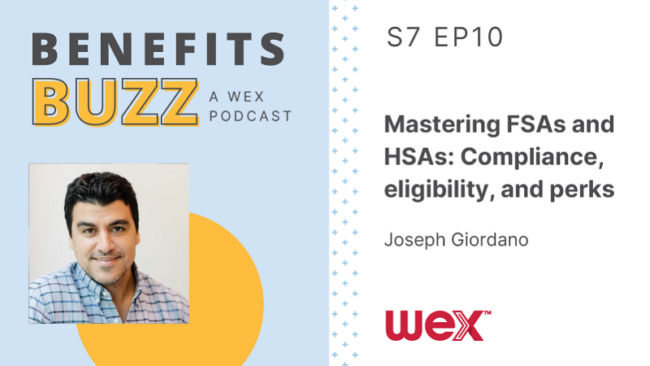Stay connected
Subscribe to our Inside WEX blog and follow us on social media for the insider view on everything WEX, from payments innovation to what it means to be a WEXer.

As we enter another season of open enrollment, one crucial topic is top of mind for many employees: HSA and FSA compliance. Health savings accounts (HSAs) and flexible spending accounts (FSAs) are often misunderstood, despite their significant financial advantages. It’s time to clarify the ins and outs of these tax-saving healthcare accounts and answer some HSA and FSA FAQs.
In our episode of Benefits Buzz below, we had the pleasure of sitting down with Joseph Giordano, compliance manager at Health-e Commerce, to discuss the most common questions around HSAs and FSAs, while diving into their key differences, eligibility requirements, and contribution rules.
At first glance, HSAs and FSAs might appear similar, but they are fundamentally different. Both allow employees to set aside pre-tax funds to cover qualified medical expenses, but that’s where most of the similarities end.
Many employees mistakenly believe that an FSA and HSA can be used simultaneously. While this is technically possible, it depends on the type of FSA offered by the employer. A limited-purpose FSA, for example, is compatible with an HSA because it only covers dental and vision expenses.
One of the most frequent questions revolves around how much employees can contribute to these accounts. Contribution limits for both accounts vary, and understanding them is essential for employees looking to maximize savings.
Why should employees consider enrolling in these accounts? The tax savings are significant. Both HSAs and FSAs allow for pre-tax contributions, but HSAs have a triple tax advantage:
Employees can save up to 30% on eligible expenses depending on their tax bracket, which can add up to significant savings over time.
When it comes to eligible expenses, many people think only of traditional healthcare costs like doctor visits or prescriptions. However, the list of eligible items is much broader, covering everyday health products such as:
For those looking ahead, vitamins and supplements might soon become eligible expenses under pending legislation, making these accounts even more versatile.
Employers need to be especially mindful of FSA deadlines, which typically fall at the end of the plan year, often on December 31st. If funds aren’t used by then, employees risk losing the money. However, employers can offer two extensions to help employees avoid forfeiting their funds:
HSAs also have their own unique rules. Employees aged 55 and older can contribute an additional $1,000, known as the catch-up contribution. Additionally, once they turn 65, HSA funds can be used for non-medical expenses, though these will be taxed as regular income.
As open enrollment season approaches, employers should prioritize educating employees about the full range of benefits offered by HSAs and FSAs. This includes clear communication around deadlines and contribution limits, as well as highlighting the significant tax savings these accounts offer.
The key takeaway? Don’t leave money on the table! By fully understanding these accounts and their advantages, both employers and employees can save a significant amount of money.
For more in-depth resources, including a comprehensive list of eligible expenses, be sure to visit the HSA Store and FSA Store. Whether you’re an HR professional or an employee, these tools can help you make the most of your HSA or FSA in the upcoming year.
The information in this blog post is for educational purposes only. It is not legal or tax advice. For legal or tax advice, you should consult your own legal counsel, tax and investment advisers.
WEX receives compensation from some of the merchants identified in its blog posts. By linking to these products, WEX is not endorsing these products.
Subscribe to our Inside WEX blog and follow us on social media for the insider view on everything WEX, from payments innovation to what it means to be a WEXer.